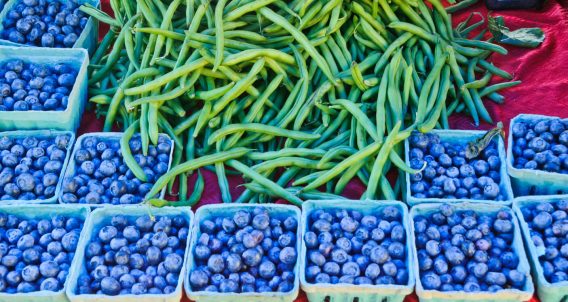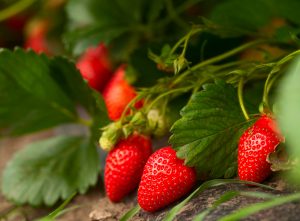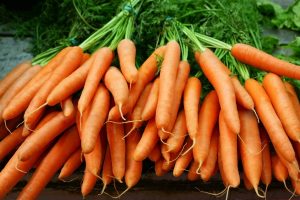Blueberries, Green Beans Among Most Pesticide-Contaminated Produce
Editors carefully fact-check all Consumer Notice, LLC content for accuracy and quality.
Consumer Notice, LLC has a stringent fact-checking process. It starts with our strict sourcing guidelines.
We only gather information from credible sources. This includes peer-reviewed medical journals, reputable media outlets, government reports, court records and interviews with qualified experts.

Two new foods recently joined the “Dirty Dozen,” a list of the most pesticide-contaminated fruits and vegetables.
The Environmental Working Group Shopper’s Guide to Pesticides in Produce added blueberries and green beans to the list of 12 nonorganic, or conventionally grown, fruits and vegetables with the highest amounts of pesticides. Alarmingly, testing found evidence of pesticides banned in the U.S.
“Despite the abundance of science linking exposure to pesticides with serious health issues, a potentially toxic cocktail of concerning chemicals continues to taint many of the nonorganic fruits and vegetables eaten by consumers,” said Alexis Temkin, Ph.D., EWG toxicologist, in the group’s press release.
EWG analyzed data from more than 46,000 samples of 46 fruits and vegetables, covering 251 different pesticides. The U.S. Department of Agriculture and the Food and Drug Administration provided the data.
“The list is meant to guide shoppers who might be particularly concerned with pesticides in the foods they eat,” Tejal Parekh, a registered and licensed dietitian in Florida, told Consumernotice.org.
“Pesticides help minimize crop damage and, therefore, improve the yields for farmers. This is important, especially in developing countries where access to food is not always guaranteed,” Parekh said. “Pesticides, however, are designed to kill living organisms and pests. EWG’s concern is that government agencies are not as strict as they should be on regulating how much pesticide is allowed in produce.”
Banned Pesticides Found in Blueberries and Green Beans
Data showed blueberry and green bean samples had concentrations of organophosphate insecticides. These pesticides can cause headaches, vomiting and muscle twitches, according to the Environmental Protection Agency. In larger concentrations they can lead to seizures, respiratory depression and loss of consciousness.
“Nine out of 10 samples of each of the popular foods had residues of pesticides – with some showing traces of up to 17 different pesticides,” EWG wrote in a statement. “Nearly 80% of blueberry samples had two or more pesticides. Phosmet was detected on more than 10% of blueberry samples, and malathion on 9%.”
Green bean samples showed more than 70% had at least two pesticides and a combined 84 different pesticides were found on the entire crop.

Strawberries top the list of most-contaminated produce.
Phosmet and Malathion
Phosmet and malathion are organophosphates that are toxic to the human nervous system and especially to children’s developing brains. Malathion is listed as a probable carcinogen.
Acephate and Methamidophos
Data showed 6% of green bean samples had residues of acephate, a pesticide that can break down into a neurotoxin known as methamidophos. The EPA banned methamidophos in 2009. Other samples showed traces of several pesticides banned in Europe but still allowed in the U.S.
Many pesticides pose environmental health dangers that negatively impact humans, including cancer, hormone disruption and brain and nervous system toxicity.
Children and pregnant women are most susceptible to toxic pesticides. The American Academy of Pediatrics says pesticide exposure to those two groups could result in low birth weight, birth defects, behavior issues, cognitive deficits, asthma and increased risk of pediatric cancer.
Organic Fruits and Vegetables a Better Option
Organic fruits and vegetables are often the better option when compared with conventionally grown food and processed foods. Consumers who want to avoid pesticides can buy organic versions or select items from EWG’s Clean Fifteen List. The produce on that list showed the lowest amount of pesticide residue during testing. Nearly 65% had no detectable levels of pesticides.
“Everyone – adults and kids – should eat more fruits and vegetables, whether organic or not,” Temkin said. “A produce-rich diet provides many health benefits.
Testing was performed on produce that had been rinsed or washed similarly to how it would be done at home. And results show that while rinsing produce won’t remove all pesticide traces, it will significantly reduce them, according to the EWG.
The Dirty Dozen List
EWG said the following fruits and vegetables showed the highest amounts of pesticides. They are listed from the most contaminated to the least.
- Strawberries
- Spinach
- Kale, collard and mustard greens
- Peaches
- Pears
- Nectarines
- Apples
- Grapes
- Bell and hot peppers
- Cherries
- Blueberries
- Green Beans

Carrots were found to have very little pesticide contamination.
The Clean Fifteen List
These fruits and vegetables had very low or no traces of pesticides. They are listed from the cleanest to the least clean.
- Carrots
- Watermelon
- Sweet Potatoes
- Mangos
- Mushrooms
- Cabbage
- Kiwi
- Honeydew Melon
- Asparagus
- Sweet Peas (frozen)
- Papaya
- Onions
- Pineapple
- Sweet corn
- Avocados
“You should still always wash fruits and vegetables under running water,” Parekh said. “Firm-skinned fruit can be scrubbed and soft-skinned fruit, like berries, can be washed in a colander under running water. This is still better than dunking your produce in water.”